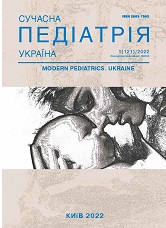Actual dynamics of the species structure of etiological pathogens of urinary tract infections in children and antibacterial sensitivity of this pathogenes
DOI:
https://doi.org/10.15574/SP.2022.121.25Keywords:
urinary tract infection, children, etiological pathogens, antibacterial resistanceAbstract
Understanding the structure of etiopathogenes of urinary tract infections (UTIs) in children, the state of antibacterial resistance (ABR) is an important component of the empirical choice of antibiotics in treatment.
Purpose - to study the species structure of UTIs pathogens in children, the prevalence of ABR the rate of its formation at the present stage.
Materials and methods. The study involved 2754 hospital and outpatient children aged 0 to 18 years with UTIs in the active phase of the disease for the period 2009-2019. The contingent of subjects was divided into 3 groups: patients for 2009, 2014 and 2019 years of follow-up.
Results. Escherichia coli was recognized as the leading uropathogen in all observation groups: in the 1st group (2009) its share was 47% (158/337), in the 2nd (2014) - 64% (210/328), in 3rd (2019) - 66.5% (252/379). The high dynamics of ABR prevalence of Escherichia coli was recognized: an increase of 11% in 2019 compared to 2014; by 18.8% compared to 2009. Thus, in 2019, every second child had resistance (57.6%±1.6 (1586/2754)) and every third - polyresistance (27.4%±3), 04 (755/2754)). We found an increase in the relative risk of ABR in 2019 1.6 times compared to 2014 and 3 times compared to 2009. The mathematical forecast of the prevalence of resistant strains of Escherichia coli for 15 years approached 100% (y=9.5x6+41=98%) at R² = 0.9918. For 10 years the indicator corresponded to 88.5%, for 5 years - 79%. The prognostic increase in ABR relative risk of 2.9-3.7 times in the next 5-10 years has been established.
Conclusions. The obtained data are of great practical importance for general practitioners and specialists, as they indicate a high rate of formation of resistant strains of Escherichia coli and other pathogens among children with UTIs, which complicates the empirical choice of antibacterial therapy.
The study was conducted in accordance with the principles of the Declaration of Helsinki. The research protocol was approved by the Local Ethics Committee of all the institutions mentioned in the work. Informed consent of the children's parents was obtained for the research.
The authors declare no conflict of interest.
References
Baumer JH, Jones RW. (2017). Urinary tract infection in children, National Institute for Health and Clinical Excellence. Arch Dis Child Educ Pract Ed. 92 (6): 189-192. https://doi.org/10.1136/adc.2007.130799; PMid:18032715
Beiraghdar F, Panahi Y, Einollahi B, Moharamzad Y, Nemati E, Amirsalari S. (2012). Predisposing factors for renal scarring in children with urinary tract infection. Saudi J Kidney Dis Transplant. 23 (3): 532-537.
Budnik TV. (2019). Microbial inflammatory diseases of the urinary system in children. Modern Pediatrics. Ukraine. 8 (104): 57-70. https://doi.org/10.15574/SP.2019.104.57
Budnik TV, Kvashnina LV, Shpyt MD, Rudyk YuYu, Androsov VО. (2020). The empirical purpose of antibacterial treatment of urinary tract infection in children: argumentation of choice and prognosis of antibiotic resistance risk. Ukrainian Journal of Perinatology and Pediatrics. 1 (81): 70-75. https://doi.org/10.15574/PP.2020.81.70
Copp HL, Schmidt B. (2015). Work up of pediatric urinary tract infection. Urology Clinika North America. 42: 519-526. https://doi.org/10.1016/j.ucl.2015.05.011; PMid:26475948 PMCid:PMC4914380
Corbel L, Howell M, Spencer JD. (2017). Clinical diagnosis and management of urinary tract infections in children and adolescents. Paediatr. Int. Children's health. 37 (4): 273-279. https://doi.org/10.1080/20469047.2017.1382046; PMid:28978286
Edlin RS, Shapiro DJ, Hersh AL et al. (2013). Antibiotic resistance patterns of outpatient pediatric urinary tract infections. J Urol. 190: 222-227. https://doi.org/10.1016/j.juro.2013.01.069; PMid:23369720 PMCid:PMC4165642
Finucane TE. (2017). Urinary Tract Infection - Requiem for a Heavyweight. J Am Geriatr Soc. 65 (8): 1650-1655. https://doi.org/10.1111/jgs.14907; PMid:28542707
Greenhow TL, Hung Y-Y, Herz AM et al. (2014). The changing epidemiology of serious bacterial infections in young infants. Pediatr Infect Dis J. 33: 595-599. https://doi.org/10.1097/INF.0000000000000225; PMid:24326416
O'Brien K, Edwards A, Hood K et al. (2013). Prevalence of urinary tract infection in acutely unwell children in general practice: a prospective study with systematic urine sampling. Br J Gen Pract. 63: e156-164. https://doi.org/10.3399/bjgp13X663127; PMid:23561695 PMCid:PMC3553642
Salo J, Ikäheimo R, Tapiainen T et al. (2011). Childhood urinary tract infections as a cause of chronic kidney disease. Pediatrics. 128: 840-847. https://doi.org/10.1542/peds.2010-3520; PMid:21987701
Shaikh N, Hoberman A, Hum SW et al. (2018). Development and Validation of a Calculator for Estimating the Probability of Urinary Tract Infection in Young Febrile Children. JAMA Pediatr. 172: 550. https://doi.org/10.1001/jamapediatrics.2018.0217; PMid:29710324 PMCid:PMC6137527
Shaikh N, Shope TR, Hoberman A, Vigliotti A, Kurs-Lasky M, Martin JM. (2016). Association Between Uropathogen and Pyuria. JM Pediatrics. 138: 1. https://doi.org/10.1542/peds.2016-0087; PMid:27328921
Wald ER. (2018). Cystitis and pyelonephritis. In: Feigin and Cherry's Textbook of Pediatric Infectious Diseases. Elsevier, Philadelphia. 8: 395.
Downloads
Published
Issue
Section
License
Copyright (c) 2022 Modern pediatrics. Ukraine

This work is licensed under a Creative Commons Attribution-NonCommercial 4.0 International License.
The policy of the Journal “MODERN PEDIATRICS. UKRAINE” is compatible with the vast majority of funders' of open access and self-archiving policies. The journal provides immediate open access route being convinced that everyone – not only scientists - can benefit from research results, and publishes articles exclusively under open access distribution, with a Creative Commons Attribution-Noncommercial 4.0 international license (СС BY-NC).
Authors transfer the copyright to the Journal “MODERN PEDIATRICS. UKRAINE” when the manuscript is accepted for publication. Authors declare that this manuscript has not been published nor is under simultaneous consideration for publication elsewhere. After publication, the articles become freely available on-line to the public.
Readers have the right to use, distribute, and reproduce articles in any medium, provided the articles and the journal are properly cited.
The use of published materials for commercial purposes is strongly prohibited.

